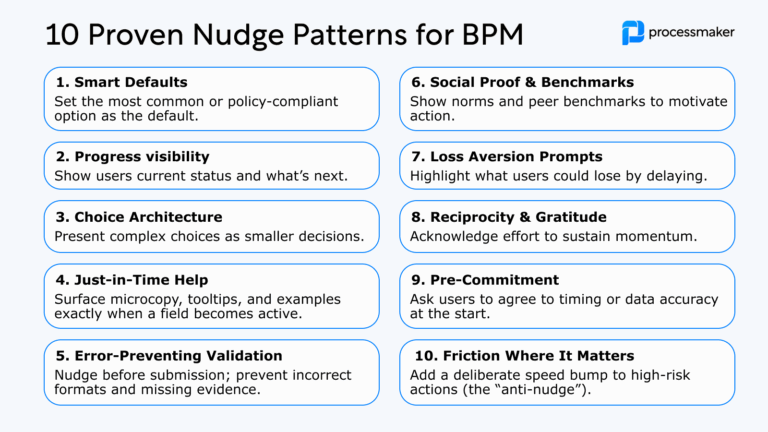This article focuses on BPMN Software, read our complete BPMN 2.0 Tutorial and Examples or Understanding BPMN Diagrams and Symbols for a more indepth look into BPMN 2.0
What is BPMN?
Business Process Modeling Notation (BPMN) is an open and standardized specification that assigns graphical notations to elements typical to most business processes, such as activities, events, and gateways. There are more than a hundred variants of the elements in the complete specification, but most processes only need a handful to be represented entirely.
BPMN software allows business process designers to facilitate:
- Communication between technical and non-technical stakeholders about business processes
- Comprehensive understanding and knowledge gaps of the business process
- A digital representation of the process on a software platform
- Business process optimization by making it easier to visualize inefficiencies and bottlenecks
Why Use a Standard Process Modeling Notation?
Many companies don’t consider how internal knowledge gaps, ad hoc processes, and inefficient business practices can cause product and production failures. This is where process modeling can help your company define its internal workflows to find bottlenecks and inefficiencies. However, before you begin to map out your workflows, it is important to consider the modeling notation to use. Choosing the right notation is the key to building communication between all stakeholders in any given business process. You should consider choosing a modeling notation that meets the following requirements.
Mutually Intelligible by All Process Stakeholders
The traditional problem when using an unstandardized business process modeling notation is that while the symbols may be the same, stakeholders tend to make up their own interpretations of every symbol. This results in different understandings of the same process, setting your company back to square one. Using a standardized notation that is well documented facilitates mutual, comprehensive understanding of the workflow and creates a basis for resolving errors and optimizing processes.
Can Be Rendered on Paper and by Your Digital Process Modeling Tool
The right business process modeling notation should not only promote communication between business users but also provide a common language for both technical and non-technical users alike. Business users should be able to map out processes on paper and hand them to programmers to be digitally rendered without losing the meaning in translation. Modeling notations that have code definitions of each process notation symbol are ideal for bridging the gap between paper and screen.
Easily Transportable Between Most Business Process Modeling Software
Many companies implement multiple process modeling tools, especially enterprises that have multiple, independent sectors or use an ERP. This can pose a problem when trying to standardize and automate business processes across the entire company. Selecting a commonly used business process modeling notation in process automation software allows your company to seamlessly transport processes from application to application, greatly helping to overcome potential errors and conflicts that arise when trying to convert between different notations.
Why Choose BPMN 2.0?
BPMN 2.0’s flexibility and ease-of-use make it ideal for most business process modeling tools.
Here are our reasons for choosing BPMN 2.0.
BPMN 2.0 Facilitates Communication Between Business Users
Most businesses are continually looking for ways to reduce costs, increase productivity and improve customer satisfaction. While many seek outside resources to supply reasons for change, only a few analyze internal processes to find hidden savings and growth opportunities. Corporations that use process modeling tools that implement BPMN to identify and address internal knowledge gaps and optimize efficiency can save time and money while improving existing asset and resource capacities.
Not only is every process accurately represented, but all stakeholders also have the tools to communicate about how to improve business processes. This creates the basis for a unified standard for process design across the entire company. Each stakeholder can now see how everyone completes their tasks to eliminate differences and streamline execution. Companies that have adopted BPMN software across their enterprise reduce the cost and increase the productivity of their existing assets. By streamlining activities and expectations to conform to the unified system, companies can decrease errors and reap the benefits.
BPMN 2.0 is Software-Friendly
BPMN has evolved to meet today’s huge demand for high quality and consistent standards across industries and software platforms. For digital use, the BPMN provides an XML definition for each element, which individualizes its meaning to a single interpretation. This eliminates the confusion that would result if multiple parties could assign different meanings to common symbols. The XML language also allows reading the BPMN 2.0 semantic model in both process execution and simulation. Therefore, companies can use BPMN in BPM and enterprise software applications to gain clarity and insight into business processes.
No entity owns the BPMN system, so businesses can use it freely for any purpose. As even more BPM platforms implement BPMN 2.0, it is easier for you to transfer your business processes between applications.
BPMN 2.0 is ISO Approved
Perhaps most significantly, the International Standards Organization (ISO) has adopted the system as a means of standardizing processes throughout the global marketplace. The Agency notes that by integrating the BPMN into its ISO/IEC 19510:2013 standard, it satisfies the entity’s need for a “ … notation that is readily understandable by all business users, from business analysts … to technical developers … to the business people who will monitor and mind those processes.” The ISO asserts that the latest (as of 2013) international standard demonstrates the best practices to define the notations and semantics of diagrams used to collaborate, process and choreograph business activities across companies, industries, and markets.
Final Benefit Analysis
BPMN 2.0 has already allowed thousands of companies to reduce their costs and improve their productivity. Each company can enhance those improvements by ensuring that stakeholders are all working together using the best business process practices. Try mapping and automating your business processes with a BPMN 2.0 process modeling tool today by starting a free trial of ProcessMaker.





